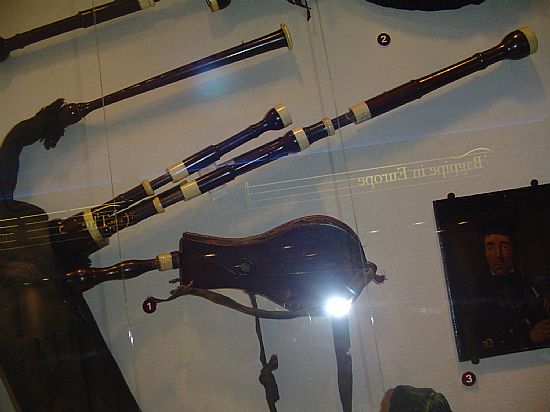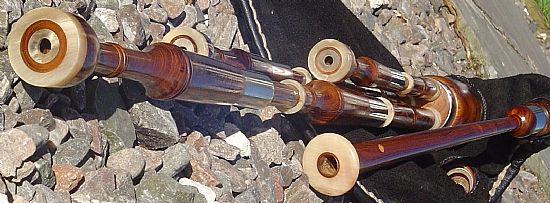|
Borderpipes
History
These pipes are related to all other conical bore European bagpipes such as the Gaita of Northern Spain. In the 17th century they were widely played by the 'Toun' pipers, musicians employed by the burghs to perform at civic functions. The name border pipe is a bit misleading as the last place it survived seems to be in the lowlands of Aberdeenshire. So the terms lowland (both sides of the borders) seems to be a bit more appropriate. There could be a place for this 'common' bagpipe to have also been played all over England. The repertoire would have been regional with some common tunes throughout the British isles with localised styles and variations. Over the past few decades Matt Seattle has been researching and publishing the Dixon manuscript. This is a fantastic porthole into the music of William Dixon of Stamfordham, Northumbria, 1733. The revival of the playing of these pipes started In the 1930s when the scout movement in Northumbria had the pipemaker Glen make sets of half long pipes for the scout bands. For the past 30-40 years, there has been a dramatic upsurge in interest led by the Lowland and Border Piping Society.
General
My pipes are inspired by the various collections we have in the museums throughout the UK. I use woods that were available to the makers of the past such as Laburnum, Holly and fruit woods, these woods give a lovely sweet tone. The mounts are made of natural materials such as contrasting woods, rams horn, buffalo horn and vegetable ivory. I use nickel silver or brass for the ferrules. Horn could also be used. Bellows blown pipes are recommended as there are no moisture and temperature changes which will cause the pitch to shift slightly. The mouth blown sets could be available with moisture control. The reeds I use are cane for the chanter and Ezee drone for the drones.
Chanters Over the past few years I have developed 2 variations of chanters. The first one sounding more like a Highland Pipe with a lot less volume and the key of A with reasonably accurate semitones (B flat, C natural, E flat, F natural and G sharp). I use a cane reed for this chanter. The second chanter that I have developed is quieter and more French in sound. I use a John Swayne style reed. The semitones are not as accurate with this chanter but a backhole for a C natural can be provided. Highland Pipe fingering is used for both chanters.
Drones The drone configuration is bass and two tenors tuning to A a a. A removable middle section that will convert one of the tenors into a bariton that will tune to D or E can also be provided. I use Ezee drone reeds. Bags and Bellows My standard bag is made of pre-treated hide which does not require seasoning. This bag system gives you a completely air tight bag. The bellows are double skinned with vinyl on the inside and leather on the outer, this eliminates the need for seasoning .The leather is then glued and nailed to the plates. The plates are made of local and recycled hardwoods such as oak, ash, teak and larch. Bag covers can be provided in tweed and other materials. Prices
Bass and two tenors,wood mounts in the key of A with chanter ,cane reed , black leather bag and bellows.-£850
Black buffalo £60 extra Rams horn £80 extra Baritone section £60 extra tweed bag cover £50 extra |
Set of Lowland bagpipes, bellows-blown, which belonged to Malcolm Macpherson,Calum Piobair (1833 - 1898).Held by the museums of scotland at the pipeing center Glasgow
Lowland bagpipes, probably made from laburnum, held at the Inverness museum Lochalshpipes
Lowland and border pipes made of lacewood and finished with sycamore and nickel silver
laburnum lowland and border pipes finnished with rams horn and nickel silver
|




 lowland and borderpipes made of laburnum, fnished with rams horn and nickel silver.
lowland and borderpipes made of laburnum, fnished with rams horn and nickel silver.
